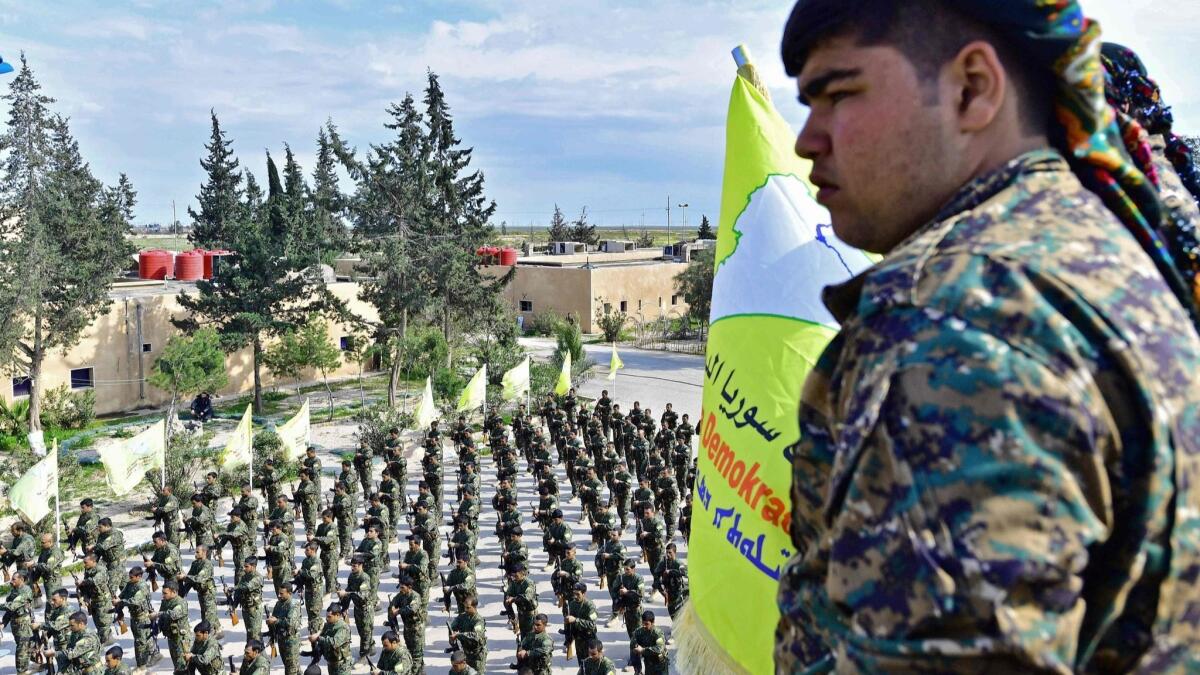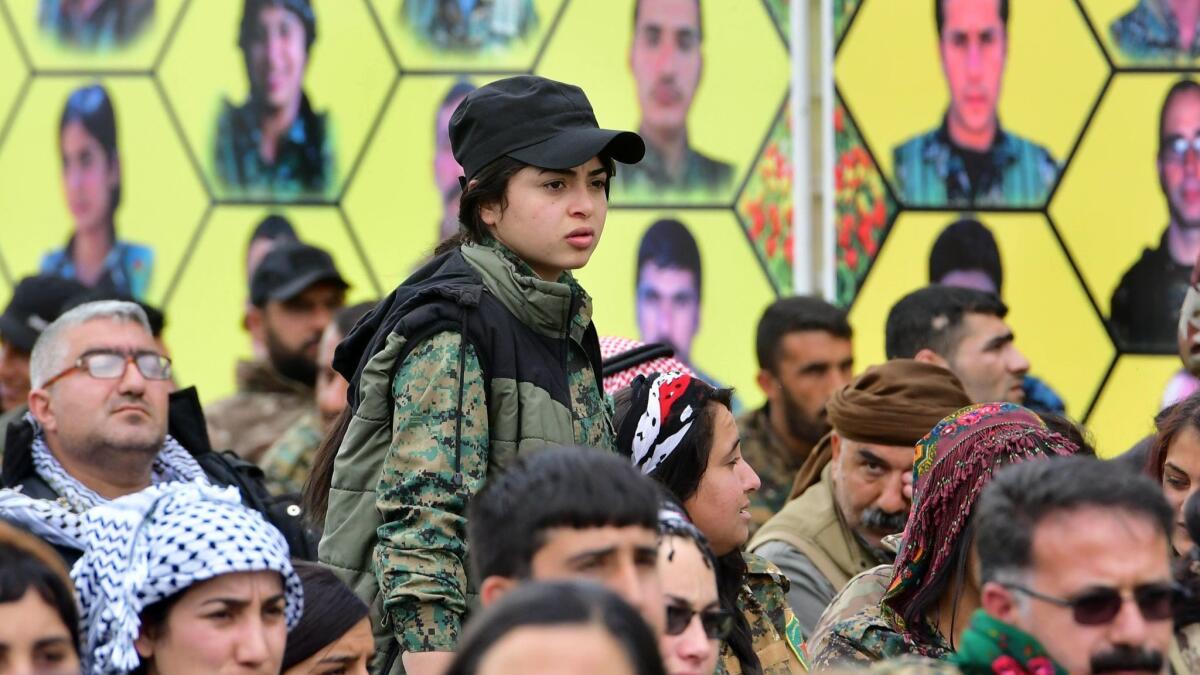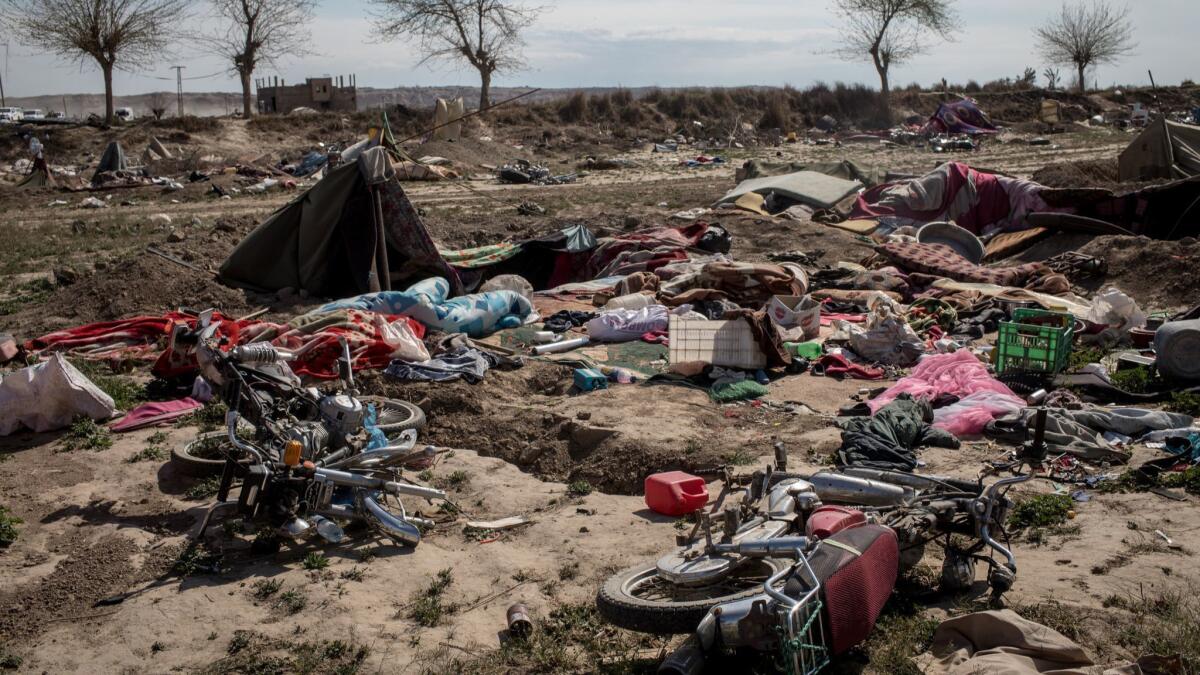In a vast, dust-swept landscape, Islamic State caliphate ends in rubble and wreckage

- Share via
Reporting from Beirut — Its militants believed they would conquer Rome, Paris and Washington. It sought to smash the century-old borders that defined the Middle East, and create a project whose central slogan was “Enduring and expanding.”
Instead, the culmination of that vision came in a dust-swept hamlet on Syria’s border with Iraq on Saturday. There, U.S.-backed Syrian and Arab militiamen punched through Islamic State’s final sliver of territory in the eastern Syrian village of Baghouz, marking the end of the almost five-year battle to destroy the caliphate.
“Syrian Democratic Forces declare total elimination of so-called caliphate and %100 territorial defeat of ISIS. On this unique day, we commemorate thousands of martyrs whose efforts made the victory possible,” tweeted Mustafa Bali, spokesman of the militiamen known collectively as the Syrian Democratic Forces or SDF.
Islamic State is also known as ISIS.
“We renew the covenant to continue the war and pursue their remnants until they are totally destroyed,” he said in another tweet.
Activists and local Kurdish outlets published videos on Saturday of the SDF’s victory parade. A red-coated marching band played a martial tune amid a throng of the group’s yellow flags, while an audience gathered before a dais for celebratory speeches.
The final weeks of the battle had been a bare-knuckled slog to dislodge the extremists, most of them Islamic State’s die-hard adherents who had shadowed the group’s retreat.
Besieged in an encampment on the edge of Baghouz, as warplanes and artillery of the U.S.-led coalition pounded what remained of their caliphate, they refused to surrender.
Images released by Islamic State’s media arm last week depicted militants racing through desert fields lined with the husks of destroyed vehicles. One video also showed women, clad from head to toe in the traditional Abaya covering, brandishing weapons and said to be firing toward Kurdish lines alongside men in the camp.
Over the last few weeks, as the offensive bore down on Baghouz, pauses in the fighting had allowed 60,000 people to head for the SDF’s internment camps, tens of miles away.
The majority of those streaming out were women and children. Islamic State families left only at the order of the group’s emirs (or commanders). They spoke of horrific conditions, with many forced to boil and eat weeds growing by the side of the road amid a maelstrom of destruction.
Many of those who emerged were foreigners; some had left their homes in nations as far away as Kazakhstan and France to help construct what was to be a religious utopia.
Though their caliphate is no more, the legacy of its destruction will endure well beyond its almost five-year existence.
The militants had been viewed as a spent force after 2010, when they were forced to retreat to the shadowlands near the Iraqi-Syrian border. But the chaos in neighboring Syria, where a raging civil war began in 2011, allowed Islamic State to export its uniquely vicious brand of terror across the border.
From its new base in eastern Syria, it launched a new offensive in Iraq in June 2014.
The militants emerged from the border area, streaking across northwestern Iraq in a blitzkrieg that netted them Mosul, the country’s second-largest city. Iraqi security forces literally threw away their U.S.-supplied weapons and ran away, bequeathing the militants an arsenal they would use to expand their territory.
A month later, the group’s leader, Abu Bakr Baghdadi, plodded to the podium of Mosul’s Grand Nouri Mosque. He declared the caliphate had been created, with him as its religious leader. Muslims worldwide owed him their fealty, and were obliged to come, he said.
Many heeded the call, including thousands of foreigners who snuck to cities in southern Turkey before making the trip into Syria.
Meanwhile, ISIS’ militants, many of them veterans of insurgent conflicts in Afghanistan and elsewhere, appeared unstoppable. They created a war machine, with its own production of car bombs, sniper rifles and even weaponized drones.
At the same time, the group’s state-building project took shape. It commandeered existing government institutions and emerged with a functioning bureaucracy that administered details as quotidian as the length of a man’s pants or the rental price for fisheries on the Euphrates River.
And, as the group’s dominion spread, so did its revenue. Oil, taxation, real estate, electric power generation, agricultural products; all were absorbed to create a functional economy that even had its own currency.
It also wielded its bureaucracy to mete out punishments dictated by its harsh interpretation of Islamic law: Homosexuals were thrown off buildings. Women were beaten for any deviation from the militants’ dress code. Islamic State’s religious police would confiscate satellite dishes and haul in for questioning those whose smartphones contained pictures that were considered haram, or forbidden.

For their enemies, the militants reserved the more creatively gruesome ways of killing.
Islamic State’s media regularly featured cinematic clips, with multiple cameras capturing the torturous death of orange-clad prisoners by drowning, immolation or beheading by sword.
But they also sought to erase the very identity of their adversaries, such as the Yazidis, members of a sect linked to Zoroastrianism but which Islamic State considered infidels.
They slaughtered their men and boys; their women and girls they pushed into sexual slavery while forcing them to convert to Sunni Islam. The children they either sent to orphanages or had them adopted by Islamic State families.
In its wake, Islamic State leaves a third of Iraq and Syria in ruins, communities ravaged by sectarian bloodshed and millions steeped in the group’s ideology.
Even for the tens of thousands who endured the final weeks of Islamic State’s violent collapse, though they emerged dust-covered and ragged from the desert, they remained defiant.

As they waited to be taken to Kurdish-run internment camps, they raised their index fingers in the Shahada, the traditional symbol of the Muslim profession of faith but which had been appropriated by Islamic State. Others hurled sand and water bottles at cameramen.
That defiance was mirrored in a speech released this week by Abu Hassan Muhajir, Islamic State’s spokesman, mocking the U.S.-led coalition’s impending victory as a “hallucination.”
The end of the caliphate, he said, would not bring “safety and peace.” Instead, it would herald “seas of blood and the flying of body parts,” a reference to the growing insurgent campaign to which Islamic State had reverted in the wake of its retreat.
Even now, he continued, thousands of fighters all over Iraq, Syria, Africa and elsewhere wait for the moment to rise again.
Far from being defeated, the “Dawlah,” as supporters call Islamic State, was victorious, said Muhajir.
“The caliphate was victorious the day its soldiers and sons were steadfast, and they are still like mountains, attacking with their faith and creed, uncaring of their enemy even when they are among them and shackled.”
More to Read
Sign up for Essential California
The most important California stories and recommendations in your inbox every morning.
You may occasionally receive promotional content from the Los Angeles Times.










